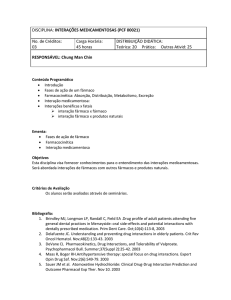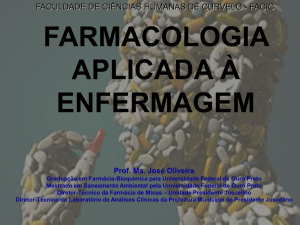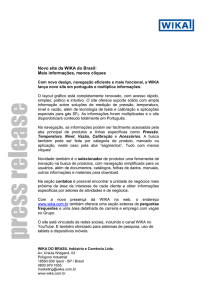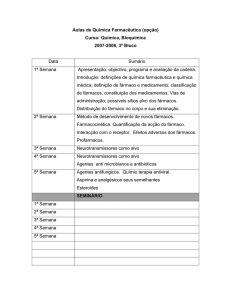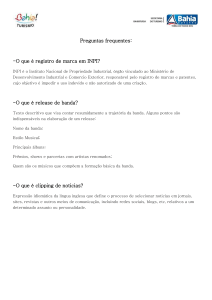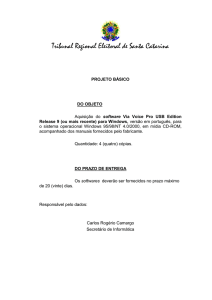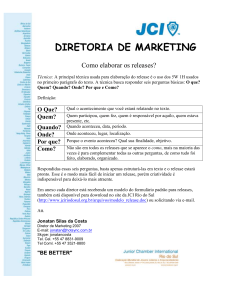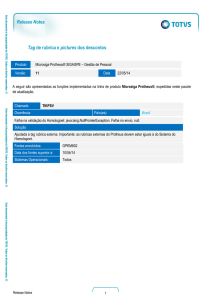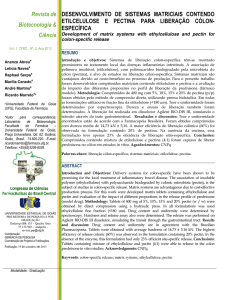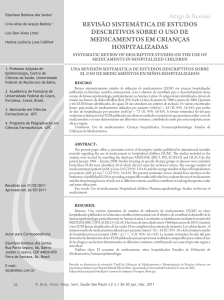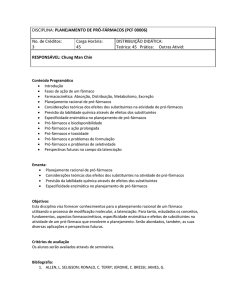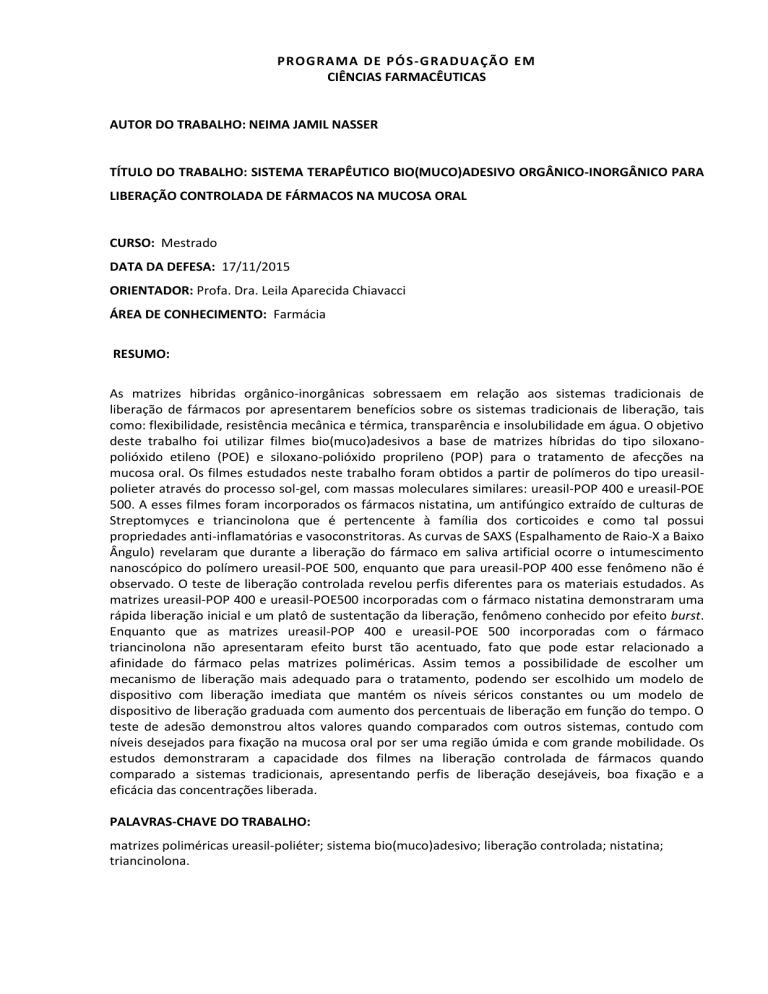
PROGRAMA DE PÓS-G RADUAÇÃO EM
CIÊNCIAS FARMACÊUTICAS
AUTOR DO TRABALHO: NEIMA JAMIL NASSER
TÍTULO DO TRABALHO: SISTEMA TERAPÊUTICO BIO(MUCO)ADESIVO ORGÂNICO-INORGÂNICO PARA
LIBERAÇÃO CONTROLADA DE FÁRMACOS NA MUCOSA ORAL
CURSO: Mestrado
DATA DA DEFESA: 17/11/2015
ORIENTADOR: Profa. Dra. Leila Aparecida Chiavacci
ÁREA DE CONHECIMENTO: Farmácia
RESUMO:
As matrizes hibridas orgânico-inorgânicas sobressaem em relação aos sistemas tradicionais de
liberação de fármacos por apresentarem benefícios sobre os sistemas tradicionais de liberação, tais
como: flexibilidade, resistência mecânica e térmica, transparência e insolubilidade em água. O objetivo
deste trabalho foi utilizar filmes bio(muco)adesivos a base de matrizes híbridas do tipo siloxanopolióxido etileno (POE) e siloxano-polióxido proprileno (POP) para o tratamento de afecções na
mucosa oral. Os filmes estudados neste trabalho foram obtidos a partir de polímeros do tipo ureasilpolieter através do processo sol-gel, com massas moleculares similares: ureasil-POP 400 e ureasil-POE
500. A esses filmes foram incorporados os fármacos nistatina, um antifúngico extraído de culturas de
Streptomyces e triancinolona que é pertencente à família dos corticoides e como tal possui
propriedades anti-inflamatórias e vasoconstritoras. As curvas de SAXS (Espalhamento de Raio-X a Baixo
Ângulo) revelaram que durante a liberação do fármaco em saliva artificial ocorre o intumescimento
nanoscópico do polímero ureasil-POE 500, enquanto que para ureasil-POP 400 esse fenômeno não é
observado. O teste de liberação controlada revelou perfis diferentes para os materiais estudados. As
matrizes ureasil-POP 400 e ureasil-POE500 incorporadas com o fármaco nistatina demonstraram uma
rápida liberação inicial e um platô de sustentação da liberação, fenômeno conhecido por efeito burst.
Enquanto que as matrizes ureasil-POP 400 e ureasil-POE 500 incorporadas com o fármaco
triancinolona não apresentaram efeito burst tão acentuado, fato que pode estar relacionado a
afinidade do fármaco pelas matrizes poliméricas. Assim temos a possibilidade de escolher um
mecanismo de liberação mais adequado para o tratamento, podendo ser escolhido um modelo de
dispositivo com liberação imediata que mantém os níveis séricos constantes ou um modelo de
dispositivo de liberação graduada com aumento dos percentuais de liberação em função do tempo. O
teste de adesão demonstrou altos valores quando comparados com outros sistemas, contudo com
níveis desejados para fixação na mucosa oral por ser uma região úmida e com grande mobilidade. Os
estudos demonstraram a capacidade dos filmes na liberação controlada de fármacos quando
comparado a sistemas tradicionais, apresentando perfis de liberação desejáveis, boa fixação e a
eficácia das concentrações liberada.
PALAVRAS-CHAVE DO TRABALHO:
matrizes poliméricas ureasil-poliéter; sistema bio(muco)adesivo; liberação controlada; nistatina;
triancinolona.
ABSTRACT:
The organic-inorganic hybrid matrices have been highlighted for drug delivery systems due to adaptive
benefits over traditional delivery systems, such as flexibility, mechanical and thermal resistance,
transparency and low water solubility. The aim of this study was the use of siloxane-type ethylene
polyethylene oxide (PEO) and proprileno siloxane-polyethylene oxide (POP) hybrid based
mucoadhesive films for the treatment of diseases in the oral mucosa. The films included in this study
were obtained by the sol-gel process using polymers of polyether ureasil type with similar molecular
weights: ureasil-POP 400 and ureasil-POE 500. The drug nystatin, an antifungal extracted from cultures
of Streptomyces, and triamcinolone which belongs to steroids family presenting anti-inflammatory and
vasoconstrictor properties, both were incorporated into these films. The SAXS curves showed that
during the release of drug in artificial saliva occurs nanoscopic swelling in the ureasil POE-500 polymer,
while for ureasil-POP 400 this phenomenon is not observed. The drug release assay showed different
profiles for the materials containing Nystatin and triamcinolone. The ureasil-POP 400 and ureasil-POE
500 matrices containing Nystatin showed a fast release in the beggining followed by a plateau of drug
release content, phenomenon known as burst effect. In contrast, ureasil-POP matrices 400 and ureasilPOE 500 containing triamcinolone showed no burst effect which may be related to the drug affinity
with the polymer matrices. This behavior allows selecting the release model depending on the
parameters needed for the treatment. The drug release model presented by the devices can be for
immediate release of the drug, keeping constant the serum levels of drug, and a graduated release of
the drug presenting an increase of the release percentage as a function of time. The adhesion test
showed high values when compared to other systems, yet with desired levels for attachment to oral
mucosa to be a moist area and high mobility. The studies demonstrated the ability of the film in the
controlled release of drugs when compared to traditional systems, with desired release profiles, good
fixation efficiency and concentrations of released.
KEY-WORDS:
ureasil-polyether polymer matrices; bio(mucus)adhesive system; controlled release; nystatin;
triamcinolone.
BANCA EXAMINADORA:
Membros Titulares:
LEILA APARECIDA CHIAVACCI (Orientador)
MARLUS CHORILLI
CRISTINA HELENA BRUNO
Membros Suplentes:
BRUNA GALDORFINI CHIARI ANDRÉO
BRUNO LEONARDO CAETANO
BIBLIOTECA DEPOSITÁRIA:
Biblioteca da Faculdade de Ciências Farmacêuticas de Araraquara -UNESP - Rodovia
Araraquara -Jaú, km 1 – Araraquara -SP

